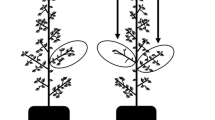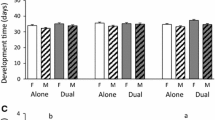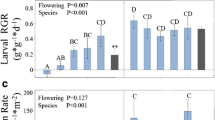Abstract
Genetic and environmental variability, and their interactions, influence phytochemical composition and, in turn, herbivore performance. We evaluated the independent and interactive effects of plant genotype, nutrient availability, and defoliation on the foliar chemistry of quaking aspen (Populus tremuloides) and consequences for performance of gypsy moths (Lymantria dispar). Saplings of four genotypes were grown under two conditions of nutrient availability and subjected to three levels of artificial defoliation. Concentrations of all secondary and primary metabolites evaluated responded to at least one or more of the experimental treatments. Of the secondary metabolites, phenolic glycosides were affected strongly by genotype, less so by nutrient availability, and not induced by defoliation. Condensed tannins were strongly dependent upon genotype, soil nutrient availability, and their interaction, and, in contrast to phenolic glycosides, were induced by artificial defoliation. Of the primary metabolites, foliar nitrogen was affected by genotype and soil nutrient availability. Starch concentrations were affected by genotype, nutrient availability, defoliation and interactions among these factors. Foliar water content responded to genotype, nutrient availability, and defoliation, and the effect of nutrient availability depended on genotype. Herbivore performance on these plants was strongly influenced by plant genotype and soil nutrient availability, but much less so by defoliation. Although several of the compound types (condensed tannins, starch, and water) responded to defoliation, quantitative variation in these compounds did not contribute to substantive changes in herbivore performance. Rather, the primary source of variation in insect performance was due to plant genotype (phenolic glycoside levels), while nutrient availability (foliar nitrogen levels) was of secondary importance. These results suggest that genetic variation in aspen plays a major role in determining patterns of insect performance, whereas environmental variation, such as was tested, here is of negligible importance.
Similar content being viewed by others
REFERENCES
ABRAHAMSON, W. G., ANDERSON, S. S., and MCCREA, K. D. 1988. Effects of manipulation of plant carbon nutrient balance on tall goldenrod resistance to a gallmaking herbivore. Oecologia 77:302-306.
AGRELL, J., MCDONALD, E. P., and LINDROTH, R. L. 2000. Effects of CO2 and light on tree phytochemistry and insect performance. Oikos 88:259-272.
BALDWIN, I. T. 1988. Short-term damage-induced increases in tobacco alkaloids protect plants. Oecologia 75:367-370.
BALDWIN, I. T. 1990. Herbivory simulations in ecological research. Tree 5:91-93.
BARNES, B. V. 1969. Natural variation and delineation of clones of Populus tremuloides and P. grandidentata in northern lower Michigan. Silvae Genet. 18:130-142.
BASSMAN, J., MYERS, W., DICKMANN, D. I., and WILSON, L. 1982. Effects of simulated insect damage on early growth of nursery-grown hybrid poplars in northern Wisconsin, USA. Can. J. For. Res. 12:1-9.
BERENBAUM, M. R. 1995. The chemistry of defense-theory and practice. Proc. Natl. Acad. Sci. U.S.A 92:2-8.
BERNAYS, E. A., and CHAPMAN, R. F. 1994. Host-Plant Selection by Phytophagous Insects. Chapman and Hall, New York.
BJöRKMAN, C., LARSSON, S., and GREF, R. 1991. Effects of nitrogen-fertilization on pine needle chemistry and sawfly performance. Oecologia 86:202-209.
BOWERS, M. D., and STAMP, N. E. 1992. Chemical variation within and between individuals of Plantago lanceolata (Plantaginaceae). J. Chem. Ecol. 18:985-995.
BRYANT, J. P., CHAPIN, F. S. I., and KLEIN, D. R. 1983. Carbon/nutrient balance of boreal plants in relation to vertebrate herbivory. Oikos 40:357-368.
BRYANT, J. P., CHAPIN, F. S. I., REICHARDT, P. B., and CLAUSEN, T. P. 1987a. Response of winter chemical defense in Alaska paper birch and green alder to manipulation of plant carbon/nutrient balance. Oecologia 72:510-514.
BRYANT, J. P., CLAUSEN, T. P., REICHARDT, P. B., MCCARTHY, M. C., and WERNER, R. A. 1987b. Effect of nitrogen-fertilization upon the secondary chemistry and nutritional-value of quaking aspen (Populus tremuloides Michx) leaves for the large aspen tortrix (Choristoneura conflictana Walker). Oecologia 73:513-517.
CLAUSEN, T. P., REICHARDT, P. B., BRYANT, J. P., WERNER, R. A., POST, K., and FRISBY, K. 1989. Chemical model for short-term induction in quaking aspen (Populus tremuloides) foliage against herbivores. J. Chem. Ecol. 15:2335-2346.
DICKMANN, D. I., and STUART, K. W. 1983. The Culture of Poplars in Eastern North America. Michigan State University, East Lansing, Michigan.
FARRAR, R. R., BARBOUR, J. D., and KENNEDY, G. G. 1989. Quantifying food consumption and growth in insects. Ann. Entomol. Soc. Am. 82:593-598.
FOLIN, O., and DENIS, W. 1912. On phosphotungstic-phosphomolybdic compounds and color reagents. J. Biol. Chem. 12:239-243.
FOULDS, W., and GRIME, J. P. 1972. The response of cyanogenic and acyanogenic phenotypes of Trifolium repens to soil moisture supply. Heredity 28:181-187.
HAGERMAN, A. E., and BUTLER, L. G. 1980. Condensed tannin purification and characterization of tannin-associated proteins. J. Agric. Food Chem. 28:947-952.
HAKULINEN, J., JULKUNEN-TIITTO, R., and TAHVANAINEN, J. 1995. Does nitrogen fertilization have an impact on the trade-off between willow growth and defensive secondary metabolism. Trees-Struct. Funct. 9:235-240.
HAN, K., and LINCOLN, D. E. 1997. The impact of plasticity and maternal effect on the evolution of leaf resin production in Diplacus aurantiacus. Evol. Ecol. 11:471-484.
HARTLEY, S. E., and LAWTON, J. H. 1991. Biochemical aspects and significance of the rapidly induced accumulation of phenolics in birch foliage, pp. 105-132, in D. W. Tallamy and M. J. Raupp (eds.). Phytochemical Induction by Herbivores. Wiley, New York.
HAVILL, N. P., and RAFFA, K. F. 1999. Effects of elicitation treatment and genotypic variation on induced resistance in Populus: Impacts on gypsy moth (Lepidoptera: Lymantriidae) development and feeding behavior. Oecologia 120:295-303.
HEMMING, J. D. C., and LINDROTH, R. L. 1995. Intraspecific variation in aspen phytochemistry: Effects on performance of gypsy moths and forest tent caterpillars. Oecologia 103:79-88.
HEMMING, J. D. C., and LINDROTH, R. L. 1999. Effects of light and nutrient availability on aspen: Growth, phytochemistry, and insect performance. J. Chem. Ecol. 25:1687-1714.
HERMS, D. A., and MATTSON, W. J. 1992. The dilemma of plants: To grow or defend. Q. Rev. Biol. 67:283-335.
HODSON, A. C. 1981. The response of aspen (Populus tremuloides) to artificial defoliation. Great Lakes Entomol. 14:167-169.
HORNER, J. D., and ABRAHAMSON, W. G. 1999. Influence of Plant genotype and early season water deficits on oviposition preference and offspring performance in Eurosta solidaginis (Diptera: Tephritidae). Am. Midl. Nat. 142:162-172.
HOULE, G., and SIMARD, G. 1996. Additive effects of genotype, nutrient availability and type of tissue damage on the compensatory response of Salix planifolia ssp. planifolia to simulated herbivory. Oecologia 107:373-378.
HUNTER, M. D., and SCHULTZ, J. C. 1995. Fertilization mitigates chemical induction and herbivore responses within damaged oak trees. Ecology 76:1226-1232.
HWANG, S.-Y., and LINDROTH, R. L. 1997. Clonal variation in foliar chemistry of aspen: Effects on gypsy moths and forest tent caterpillars. Oecologia 111:99-108.
HWANG, S.-Y., and LINDROTH, R. L. 1998. Consequences of clonal variation in aspen phytochemistry for late season herbivores. Ecoscience 5:508-516.
JONES, C. G., and HARTLEY, S. E. 1999. A protein competition model of phenolic allocation. Oikos 86:27-44.
JULKUNEN-TIITTO, R., BRYANT, J. P., KUROPAT, P., and ROININEN, H. 1995. Slight tissuewounding fails to induce consistent chemical defense in 3 willow (Salix spp.) clones. Oecologia 101:467-471.
KARBAN, R. 1992. Plant variation: Its effects on populations of herbivorous insects, pp. 195-215, in R. S. FRITZ and E. L. SIMMS (eds.). Plant Resistance to Herbivores and Pathogens. University of Chicago Press, Chicago.
KARBAN, R. 1993. Costs and benefits of induced resistance and plant density for a native shrub, Gossypium thurberi. Ecology 74:9-19.
KARBBAN, R., and BALDWIN, I. T. 1997. Induced Responses to Herbivory. University of Chicago Press, Chicago.
KEINäNEN, M., JULKUNEN-TIITTO, R., MUTIKAINEN, P., WALLS, M., OVASKA, J., and VAPAAVUORI, E. 1999. Trade-offs in phenolic metabolism of silver birch: Effects of fertilization, defoliation, and genotype. Ecology 80:1970-1986.
KINNEY, K. K., and LINDROTH, R. L. 1997. Responses of three deciduous tree species to atmospheric CO2 and soil NO 3- availability. Can. J. For. Res. 27:1-10.
KINNEY, K. K., LINDROTH, R. L., JUNG, S. M., and NORDHEIM, E. V. 1997. Effects of CO2 and soil NO 3- availability on deciduous trees: Phytochemistry and insect performance. Ecology 78:215-230.
KORICHEVA, J., LARSSON, S., HAUKIOJA, E., and KEINäNEN, M. 1998. Regulation of woody plant secondary metabolism by resource availability: Hypothesis testing by means of meta-analysis. Oikos 83:212-226.
KRISCHIK, V. A., and DENNO, R. F. 1983. Individual, population, and geographic patterns in plant defense, pp. 463-512, in R. F. Denno and M. S. McClure (eds.). Variable Plants and Herbivores in Natural and Managed Systems. Academic Press, New York.
LANG, C. A. 1958. Simple microdetermination of Kjeldahl nitrogen in biological materials. Anal. Chem. 30:1692-1694.
LARSSON, S., WIREN, A., LUNDGREN, L., and ERICSSON, T. 1986. Effects of light and nutrient stress on leaf phenolic chemistry in Salix dasyclados and susceptibility to Galerucella lineola (Coleoptera). Oikos 47:205-210.
LINDROTH, R. L., and BLOOMER, M. S. 1991. Biochemical ecology of the forest tent caterpillar: Responses to dietary protein and phenolic glycosides. Oecologia 86:408-413.
LINDROTH, R. L., and HEMMING, J. D. C. 1990. Responses of the gypsy moth (Lepidoptera: Lymantriidae) to tremulacin, an aspen phenolic glycoside. Environ. Entomol. 19:842-847.
LINDROTH, R. L., and HWANG, S.-Y. 1996. Diversity, redundancy, and multiplicity in chemical defense systems of aspen, pp. 25-56, in J. T. Romeo, J. A. Saunders, and P. Barbosa (eds.). Phytochemical Diversity and Redundancy in Ecological Interactions. Plenum Press, New York.
LINDROTH, R. L., and KINNEY, K. K. 1998. Consequences of enriched atmospheric CO2 and defoliation: Chemistry and gypsy moth performance. J. Chem. Ecol. 24:1677-1695.
LINDROTH, R. L., and KOSS, P. A. 1996. Preservation of Salicaceae leaves for phytochemical analyses: Further assessment. J. Chem. Ecol. 22:765-771.
LINDROTH, R. L., KINNEY, K. K., and PLATZ, C. L. 1993. Responses of deciduous trees to elevated atmospheric CO2: Productivity, phytochemistry, and insect performance. Ecology 74:763-777.
LITTELL, R. C., MILLIKEN, G. A., STROUP, W. W., and WOLFINGER, R. D. 1996. SAS System for Mixed Models. SAS Institute Inc., Cary, North Carolina.
MATTSON, W. J. 1980. Herbivory in relation to plant nitrogen content. Annu. Rev. Ecol. Syst. 11:119-161.
MATTSON, W. J., and PALMER, S. R. 1988. Changes in levels of foliar minerals and phenolics in trembling aspen, Populus tremuloides, in response to artificial defoliation, pp. 157-169, in W. J. Mattson, J. C. Levieux, and B. Dagan (eds.). Mechanisms of Woody Plant Defences Against Insects: Search for Pattern. Springer-Verlag, New York.
MITTON, J. B., and GRANT, M. C. 1996. Genetic variation and the natural history of quaking aspen. Bioscience 46:25-31.
MUTIKAINEN, P., WALLS, M., OVASKA, J., KEINäNEN, M., JULKUNEN-TIITTO, R., and VAPAAVUORI, E. 2000. Herbivore resistance in Betula pendula: Effect of fertilization, defoliation, and plant genotype. Ecology 81:49-65.
NEF, L. 1988. Interactions between the leaf miner, Phyllocnistis suffusella, and poplars, pp. 239-251, in W. J. Mattson, J. C. Levieux, and B. Dagan (eds.). Mechanisms of Woody Plant Defences Against Insects: Search for Pattern. Springer-Verlag, New York.
NEUVONEN, S., and HAUKIOJA, E. 1985. How to study induced plant resistance. Oecologia 66:456-457.
ORIANS, C. M., and FRITZ, R. S. 1996. Genetic and soil-nutrient effects on the abundance of herbivores on willow. Oecologia 105:388-396.
ORIANS, C. M., FRITZ, R. S., and CLAUSEN, T. P. 1993. The genetic basis for variation in the concentration of phenolic glycosides in Salix sericea: Clonal variation and sex-based differences. Biochem. Syst. Ecol. 21:535-542.
OSIER, T. L., HWANG, S. Y., and LINDROTH, R. L. 2000. Effects of phytochemical variation in quaking aspen Populus tremuloides clones on gypsy moth Lymantria dispar performance in the field and laboratory. Ecol. Entomol. 25:197-207.
PARKINSON, J. A., and ALLEN, S. E. 1975. A wet oxidation procedure suitable for the determination of nitrogen and mineral nutrients in biological material. Commun. Soil Sci. Plant Anal. 6:1-11.
PERALA, D. A. 1990. Populus tremuloides Michx. quaking aspen, in R. M. Burns and B. H. Honkala (eds.). Silvics of North America. United States Department of Agriculture Forest Service, Washington, D.C.
PORTER, L. J., HRSTICH, L. N., and CHAN, B. G. 1986. The conversion of procyanidins and prodelphinidins to cyanidin and delphinidin. Phytochemistry 25:223-230.
RAUBENHEIMER, D., and SIMPSON, S. J. 1992. Analysis of covariance: An alternative to nutritional indices. Entomol. Exp. Appl. 62:221-231.
REICHENBACKER, R. R., SCHULTZ, R. C., and HART, E. R. 1996. Artificial defoliation effect on Populus growth, biomass production, and total nonstructural carbohydrate concentration. Environ. Entomol. 25:632-642.
ROSSI, A. M., and STILING, P. 1998. The interactions of plant clone and abiotic factors on a gall-making midge. Oecologia 116:170-176.
ROTH, S. K., LINDROTH, R. L., VOLIN, J. C., and KRUGER, E. L. 1998. Enriched atmospheric CO2 and defoliation: Effects on tree chemistry and insect performance. Global Change Biol. 4:419-430.
ROUSI, M., TAHVANAINEN, J., HENTTONEN, H., HERMS, D. A., and UOTILA, I. 1997. Clonal variation in susceptibility of white birches (Betula spp.) to mammalian and insect herbivores. For. Sci. 43:396-402.
SAS INSTITUTE. 1989. SAS User's Guide: Statistics, Versions 8. SAS Institute Inc., Cary, North Carolina.
SCHULTZ, J. C. 1988. Many factors influence the evolution of herbivore diets, but plant chemistry is central. Ecology 69:896-897.
SCRIBER, J. M., and SLANSKY, F. 1981. The nutritional ecology of immature insects. Annu. Rev. Entomol. 26:183-211.
SLANSKY, F. 1993. Nutritional ecology: the fundamental quest for nutrients, pp. 29-91, in N. E. Stamp and T. M. Casey (eds.). Caterpillars: Ecological and Evolutionary Constraints on Foraging. Chapman and Hall, New York.
SOKAL, R. R., and ROHLF, F. J. 1995. Biometry, 3rd ed. Freeman and Company, New York.
STILING, P., and ROSSI, A. M. 1996. Complex effects of genotype and environment on insect herbivores and their enemies. Ecology 77:2212-2218.
TUOMI, J., NIEMELä, P., CHAPIN, F. S. I., BRYANT J. P., and SIREN, S. 1988. Defensive responses of trees in relation to their carbon/nutrient balance, pp. 57-72, in W. J. Mattson, J. C. Levieux, and B. Dagan (eds.). Mechanisms of Woody Plant Defences Against Insects: Search for Pattern. Springer-Verlag, New York.
WALDBAUER, G. P. 1968. The consumption and utilization of food by insects. Adv. Insect Physiol. 5:229-288.
Author information
Authors and Affiliations
Rights and permissions
About this article
Cite this article
Osier, T.L., Lindroth, R.L. Effects of Genotype, Nutrient Availability, and Defoliation on Aspen Phytochemistry and Insect Performance. J Chem Ecol 27, 1289–1313 (2001). https://doi.org/10.1023/A:1010352307301
Issue Date:
DOI: https://doi.org/10.1023/A:1010352307301




